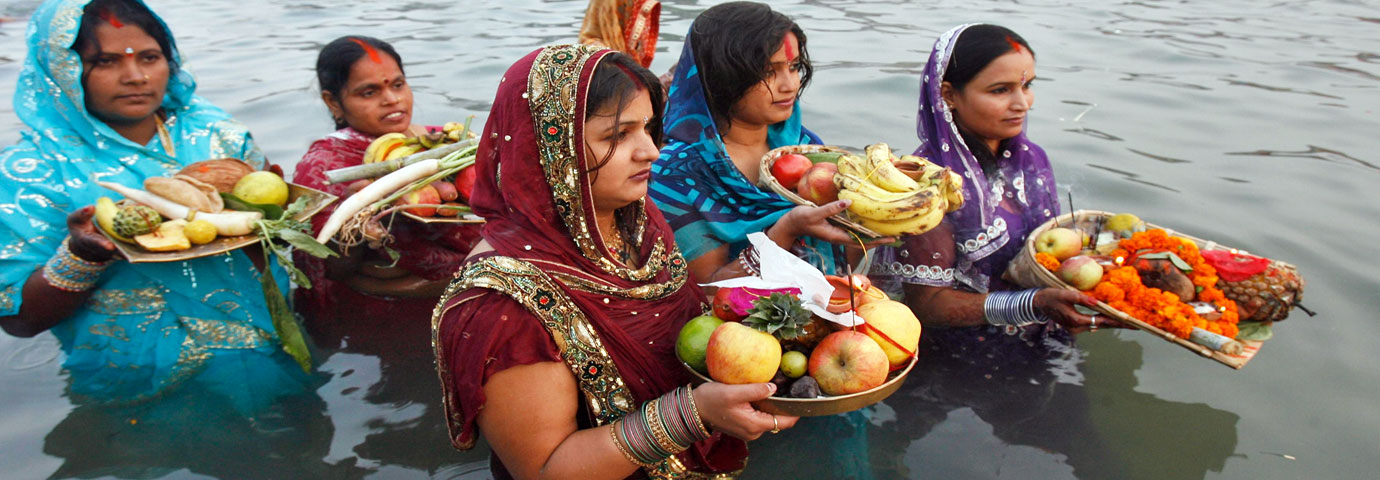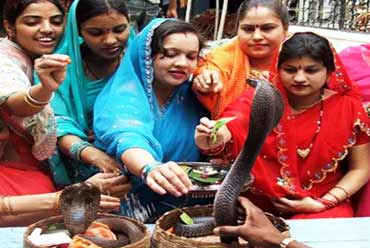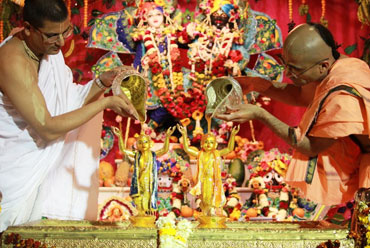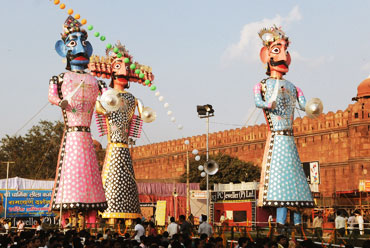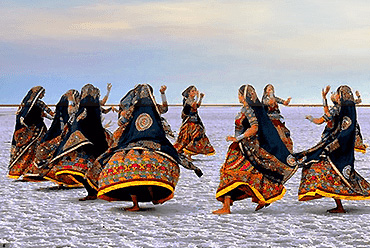A week after Diwali, the festival of lights, comes the festival Chhath. For one night and day, the people of Bihar practically live on the banks of the river Ganga when a ritual offering is made to the Sun God.The word Chhath denotes the number six and thus the name itself serves as a reminder of this auspicious day on the festival almanac. The venue for this unique festival is the riverbank and since the Ganga transverses the countryside of Bihar like a lifeline, it is but appropriate that the banks of this river should be the ideal prayer location. Chhath is considered a means to thank the Sun for bestowing the bounties of life on earth as also for fulfilling particular wishes.
Celebrations
With no temples to visit, or house to spruce up before the festival, one would conclude that Chhath puja would be an easy sail through. However, for this puja, things are anything but easy and the ritual observances of this occasion would make a medieval Franciscan Order appear frivolous.
The celebrations of the days are as follows: on the day before the actual worship, devotees take a cleansing dip, preferably in the Ganges, and bring back some holy water to prepare the offerings. A fast is observed for the whole day and late in the evening, the devotees, after performing worship at home, break their fast. The offerings -typically a rice porridge, puris (deep fried puffs of wheat flour) and bananas - are shared among family and visiting friends and relatives. On the second day, the 24-hour fast begins. The day is spent in the preparation of offerings at home and in the evening, the devotees move to a riverbank (or a pond). There, offerings are made to the setting sun. At nightfall, the devotees return home where another colorful celebration takes place. Under a canopy of sugar cane sticks, clay elephants containing earthen lamps, and containers full of the offerings are placed. There the fire god is worshipped. Devotees maintain a strict fast without even water. Just before sunrise, the devotees reach the riverbank again and offer prayers to the rising sun. Once the prayers are done, the devotees break their fast with the prasad or the offerings. After that, the prasad is distributed among family, friends and anyone who asks for it. The offerings characteristically consist of deep-fried and sweet rolls of stone ground wheat flour, grapefruit, whole coconuts, bananas, and grains of lentils. During the puja, these items are contained in small, semicircular pans woven out of bamboo strips called soop.
Chhath is a very colorful festival and new clothes are a must for the devotees. There is much music and a lot of singing of folk and devotional songs, both at home and on the riverbank. In Patna, millions of people throng the banks of the river Ganges for miles and the camaraderie this festival evokes is unparalled.
Rituals
Almost immediately after the merriment of Diwali subsided, the solemnity of Chhath takes over. Adult married women of the household make all the preparations that are required for the puja. While the younger women and children take over the everyday household chores, these women begin with a thorough spring-cleaning of all the things that would be used to prepare the prasad or food offerings to the Sun God. Everything, from the kitchen chulha to the ladles, cooking wok, and, frying pan, is purified.
It is the bounty of the harvest, which is deemed a fit offering to the Sun god. Newly pounded rice is soaked and made into a paste. Dry fruits, nuts and slivers of coconut are used as flavoring and the cooked lump is then rolled in the palms, into hardened laddoos. Wheat flour becomes the main ingredient for the traditional cake called thekuwa. The dough is cut into shapes or pressed into wooden moulds before they are fried a crisp deep brown, to be eaten as a crumbling mouthful. Generous amounts of clarified butter, oodles of jaggery and coconut shavings go into this equivalent of the cookie.For the preparation of these offerings, the lady in command observes certain rules like abstaining from eating cooked meals and not wearing stitched clothes. A bath before entering the kitchen is a must for everyone.
By the time the day of the fast arrives, all the preparations are complete and a solemn atmosphere prevails. Accompanied by chorus renditions of traditional devotional songs, the procession, which begins as a small group at a doorstep, becomes a surging crowd of devotees as one nears the riverbanks. In the procession, bare-chested men carry the prasad in a basket of bamboo weaves. The basket is held high above the crowds' hands for the fear of it being soiled by a chance impure touch. Within it are the laddoos, thekuwas and of course the fruits of the season. Coconuts, a bunch of bananas, an orange or two and always an earthen lamp, covered with a cotton cloth, dyed in turmeric, are the unchangeable contents.
No one tells the hour of prayer but, almost magically, the procession is timed to accuracy and the prayers are offered at the moment the Sun sets. On the banks of the river, no one can afford to slip or falter, as that would mean an evil portent. As the western sky of early winter turns rosy, the scene is a concerted vision of devotion as countless up-stretched arms hold aloft the glistening bamboo trays and baskets. The veiled oil lamps are gently glowing and a chorus of hymns rings the air. Minutes pass, and the faces become blurred as the crowd begins the walk back, leading away from the riverfront.
Having paid homage to the setting sun, the next day, one must make ready for the daybreak obeisance. This is the crucial part of the ritual and the journey towards the river begins when not even the slightest hint of sunlight is visible. It is a mahogany black sky outside as the festival falls during the dark phase of the moon. One can tell when the riverbank is near from the smell of dew soaked grass and lapping of water. This time the faces turn eastward and instead of just standing on the riverbank, the devotees enter the water for the customary holy dip. In the meantime, the baskets are left securely under a temporary canopy, made of freshly harvested sugar cane stalks. A four-sided platform is made especially for this with its corners decorated with terra cotta lamps shaped like elephants or birds. Sandalwood paste, vermilion, wet rice, flowers and fruits, covered over with red dyed cotton cloth, to ward off evil designs and spirits, add the right note of sanctity. Once the first streaks appear on the horizon, men and women, dressed in their saris and dhotis (loin cloth) plunge into the shallow waters. Having found a foothold and completely oblivious of the chilling waters, they begin the timeless mantra of the Rig Veda, specific to the Sun-the Gayatri Mantra.
Regional Celebrations
The festival of Chhath is celebrated only in Bihar with traditional fervor. This festival is exclusive to the state of Bihar as no other state celebrates this festival of thanksgiving to the Sun God.
Places To Visit
The best place to witness this festival is Bihar especially the northern parts of the state. The festivities and tradition of this festival are worth experiencing. The preparation of delicious sweets and other goodies is an important part of the festival.

